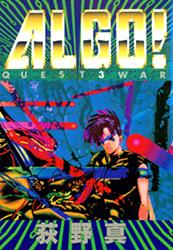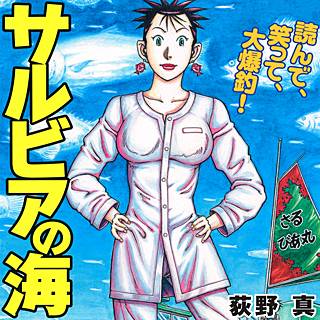Makoto Ogino (1959-2019)
May 11, 2019 · 0 comments
 Makoto Ogino, who died of renal failure on 29th April, spent his whole life preoccupied with the wheel of karma. On the day of his very first sale, his father, an education officer responsible for censuring unsuitable books, pleaded with him not to become the sort of manga creator whose works would get denounced in public, only for Ogino to embark upon several decades drawing graphic nudity, violence and exorcisms.
Makoto Ogino, who died of renal failure on 29th April, spent his whole life preoccupied with the wheel of karma. On the day of his very first sale, his father, an education officer responsible for censuring unsuitable books, pleaded with him not to become the sort of manga creator whose works would get denounced in public, only for Ogino to embark upon several decades drawing graphic nudity, violence and exorcisms.
His best-known creation was Kujaku, a handsome, youthful Buddhist monk, unapologetic about his indulgences in sins of the flesh, whose demon-hunting abilities turn out to be the result of multiple past-life accomplishments. As later chapters of Kujaku-Oh (1984) reveal to readers of Young Jump magazine, our hero is the reincarnation of important figures from world religions, all of which struggle to describe the true nature of the spirit world. Kujaku is both a demon hunter and a demons’ prey, since the right combination of holy artefacts – his blood poured into the skull of Christ, for example – could form the correct ritual to summon a Buddhist death god.
Kujaku-Oh was swiftly snapped up in the media frenzy for 1980s hokum, going straight-to-video as anime and two Hong Kong chop-socky movies, as well the video games SpellCaster and Mystic Defender. Ogino, however, came to resent the work that made his name – partly because he didn’t approve either of the adaptations or the low returns they brought him, but also because he faced constant editorial pressures to compromise his own artistic vision.
 Ogino first tried to break free with ALGO! (1989) in which a hacker is pursued by agents of an Arab despot, determined to acquire the motherboard that functions as a gateway to a fantastic cyber-realm. Inevitably, the Satan-figure from this otherworld is trying to escape to Earth, plunging modern Tokyo into a magical-cybernetic disaster. Editors at Young Jump let Ogino have his fun for six months, and then sent him back to work on Kujaku-Oh, while he grumbled that the Japanese public wasn’t ready for cyberpunk. He made two more attempts in the 1990s to throw off Kujaku-Oh’s yoke, but neither his reimagining of Japanese myth, Demon Crow (1994), nor his duelling psychic schoolkids in Child (1997) flourished quite as well.
Ogino first tried to break free with ALGO! (1989) in which a hacker is pursued by agents of an Arab despot, determined to acquire the motherboard that functions as a gateway to a fantastic cyber-realm. Inevitably, the Satan-figure from this otherworld is trying to escape to Earth, plunging modern Tokyo into a magical-cybernetic disaster. Editors at Young Jump let Ogino have his fun for six months, and then sent him back to work on Kujaku-Oh, while he grumbled that the Japanese public wasn’t ready for cyberpunk. He made two more attempts in the 1990s to throw off Kujaku-Oh’s yoke, but neither his reimagining of Japanese myth, Demon Crow (1994), nor his duelling psychic schoolkids in Child (1997) flourished quite as well.
Some of Ogino’s frustration was an echo of other creators’ – alienated from the profits of their labours, beholden to managerial demands. But he was also caught in an impossible situation, with editors that demanded more gore and violence one week, only to retrench in horror at the latest political backlash. In 2000, he embarked upon The Gun Spirit, an attempt to reframe Wild West gun-slinging in modern Japan. Except as soon became apparent, guns were simply not used that much by either Japanese criminals or police, while an attempts to turn it into an anti-terrorism story was scotched by editorial timidity in the wake of the 9/11 al-Qaida attacks. Seemingly turning to sci-fi in despair, Ogino turned the main antagonist into a mutant.
He also had to deal with a public loss of face, when the author Baku Yumemakura accused Kujaku-Oh of plagiarising his own Psyche Diver series. Later volumes of Kujaku-Oh grudgingly acknowledge Yumemakura as an “inspiration”, in a settlement that skirted around the issues of who owns the right to retell folklore in a modern setting. Plagued with health scares for the last ten years of his career, Ogino would continue to tread a fine line between homage and theft, particularly in some of the manga he created while in hospital. Plainly not expecting to leave the ward alive, he dashed off Angry Spirit Warrior (2003) with some blatant steals from Silent Hill and John Carpenter’s They Live, although nobody seems to have complained.
Ogino shifted largely to adult venues, disenchanted with creative pressures in the teenage market. This sometimes meant that he would cancel one title in a teen magazine, only to resurrect it with cosmetic changes in a magazine for adults. Loyal readers were forced to conduct a form of literary archaeology on Ogino’s work, shuffling differing narratives, with different character names, created for venues with differing standards, sometimes years apart and even set in different timelines, in order to create the story Ogino meant to tell.
 Late in life, he finally seemed to find a happy groove with Oboko (2003), the tale of a plucky girl who inherits her father’s fishing boat, and finds herself renting it out to a handsome schoolteacher with a vocation for environmental activism. In one of the cruellest twists of fate, editors at the recession-hit Business Jump told him that new policies found it to not have enough sex and violence for their readership. After some half-hearted attempts to make it a little steamier, Ogino shut it down, telling his readers that a new work in another venue, The Sea of Sarubia (2010), would be its distaff continuation.
Late in life, he finally seemed to find a happy groove with Oboko (2003), the tale of a plucky girl who inherits her father’s fishing boat, and finds herself renting it out to a handsome schoolteacher with a vocation for environmental activism. In one of the cruellest twists of fate, editors at the recession-hit Business Jump told him that new policies found it to not have enough sex and violence for their readership. After some half-hearted attempts to make it a little steamier, Ogino shut it down, telling his readers that a new work in another venue, The Sea of Sarubia (2010), would be its distaff continuation.
In his last years, he let Kujaku-oh pull him back in, and died having supposedly completed the final chapters of two new iterations, which will come to an end this summer. But he also found the time to embark on a personal project, the short-story collection 15 Springs (2010), each chapter of which visits a major historical figure (Catherine the Great, Charles Darwin, Genghis Khan…) at a formative moment in their teen years. The series demonstrated an unexpected side to the storyteller who will be remembered for his grotesque and visceral demon battles: a compassion and empathy for the doubts and hopes of youth.
Leave a Reply